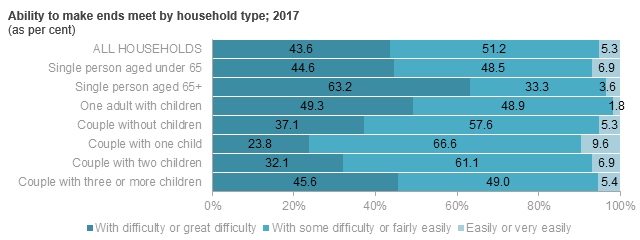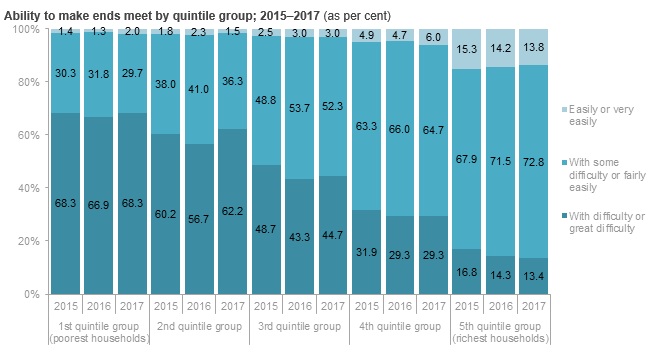Analytics, Financial Services, Latvia, Society, Wages
International Internet Magazine. Baltic States news & analytics
Saturday, 20.12.2025, 00:40
43.6% Latvian households make ends meet with difficulty
 Print version
Print versionMore than a half of households (51.2%) paid for usual necessary expenses with some difficulty or fairly easily, which is 1.6 percentage points less than in 2016, whereas the proportion of households making ends meet easily or very easily almost did not change and constituted 5.1% in 2016 and 5.3% in 2017.
Household ability to make ends meet; 2014–2017 (as per cent, sum of answers 100%)
|
|
2014 |
2015 |
2016 |
2017 |
|
With difficulty or great difficulty |
50.5 |
45.2 |
42.1 |
43.6 |
|
With some difficulty or fairly easily |
45.7 |
49.7 |
52.8 |
51.2 |
|
Easily or
very easily |
3.8 |
5.2 |
5.1 |
5.3 |
The most positive perception of their ability to make ends meet still was observed in Kurzeme region – 7% of the population in this region pay for usual necessary expenses easily or very easily (7.8% in 2016), while in Riga indicator constituted 6.7%. The most pessimistic perception, in turn, was recorded in Latgale and Zemgale regions, in which more than a half of households (55.2% and 54.6%, respectively) indicated that pay for usual necessary expenses with difficulty or great difficulty.
Household ability to make ends meet in regions, urban and rural areas; 2017 (as per cent, sum of answers 100%)
|
|
With difficulty or great difficulty |
With some difficulty or fairly easily |
Easily or
very easily |
|
Urban
areas |
42.6 |
51.9 |
5.4 |
|
Rural
areas |
45.9 |
49.3 |
4.8 |
|
Riga |
35.0 |
58.3 |
6.7 |
|
Pierīga |
47.2 |
49.0 |
3.8 |
|
Vidzeme |
44.6 |
52.1 |
3.3 |
|
Kurzeme |
37.5 |
55.5 |
7.0 |
|
Zemgale |
54.6 |
42.3 |
3.0 |
|
Latgale |
55.2 |
39.5 |
5.3 |
The greatest difficulty to pay for usual necessary expenses was observed in households consisting of single person aged over 65, one adult with children, as well as couples with three or more children. Out of the households of single persons aged over 65 and those of one adult with children, 63.2% and 49.3%, respectively, admitted that make ends meet with difficulty or great difficulty.

In 2017, Latvia population pointed out that one household member would need at least EUR 509 monthly to make ends meet. It is almost the same amount mentioned in 2016 when Latvia population indicated that one household member would need at least EUR 510 monthly, and household disposable income constituted 85.7% of the sum, reaching EUR 437 per household member monthly.
In 2016, households having lower income (belonging to the 1st and 2nd quintile group) were those that were not able to make ends meet the most often and were indicating significantly smaller sums that would be needed to pay for usual necessary expenses. Households of the 1st quintile group mentioned that one household member would need at least EUR 359 monthly to make ends meet, and 2nd quintile households mentioned that they would need at least EUR 436 monthly. However, disposable income of the mentioned households lacked behind the minimum needed sum notably. Disposable income of the 1st quintile group households constituted 42.9% of the minimum sum to make ends meet, reaching EUR 154 per household member monthly. Situation in households belonging to the 2nd quintile group was slightly better – disposable income in this quintile group reached 61% of the minimum sum to pay for usual necessary expenses, reaching EUR 266 per household member monthly.

In 2017, 68.3% of the poorest households (1st quintile group) paid for usual necessary expenses with difficulty or great difficulty. The share of such households among richest households (5th quintile group) was notably smaller – 13.4%. Moreover, compared to the households belonging to the two bottom quintiles, households of the top quintile indicated significantly higher sum needed to make ends meet – at least EUR 711 per household member monthly.
Population opinion about sums needed to make ends meet and household disposable income statistics was acquired with the help of the European Union Statistics on Income and Living Conditions (EU-SILC) 2017 survey conducted by the CSB. The survey covered 6 thousand households and 11.3 thousand respondents aged 16 and over were interviewed. Data on household disposable income in 2017 will be acquired within the EU-SILC survey that will be conducted from March to June 2018. The CSB would like to express gratitude to everyone who took part in the survey and completed electronic questionnaire from 1 to 14 February. Online questionnaire was filled in by 14% of the respondents.
More information on housing conditions is available in CSB database section Personal Income, Monetary Poverty and Income Inequality. Latest data are published in the CSB database section Material Deprivation.
Methodological explanations
Household– several persons living in one dwelling and sharing expenditure or one person having separate housekeeping. CSB data show that, in 2016 in one household on average there were 2.4 persons.
Disposable (net) income– cash income from labour, employee income in kind received by using company car for private needs estimated in cash, income or losses received from self-employment, pensions and benefits received, regular material assistance from other households, profit from deposit interest, dividends, shares, income received by children aged under 16, income from property rental, receipts for tax adjustments from the State Revenue Service (for business activities, eligible costs – education, medical treatment etc.).
Quintile group– one fifth (20%) of the number of surveyed households grouped in increasing sequence according to the disposable income per one household member. The lowest (1st or bottom) quintile group includes one fifth of the households with the lowest income, while the highest (5th or top) – one fifth of the households with the highest income.








 «The Baltic Course» Is Sold and Stays in Business!
«The Baltic Course» Is Sold and Stays in Business!

